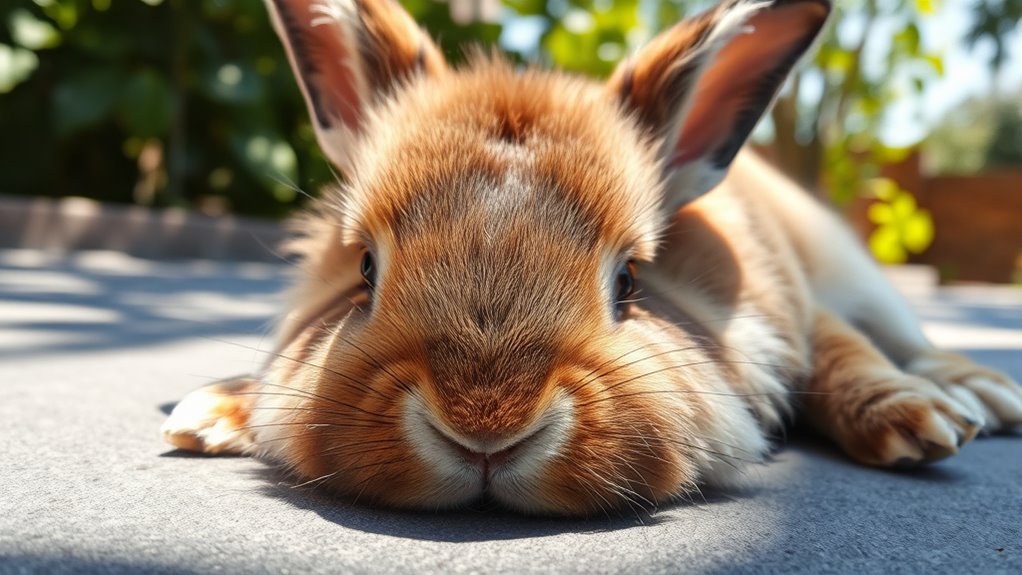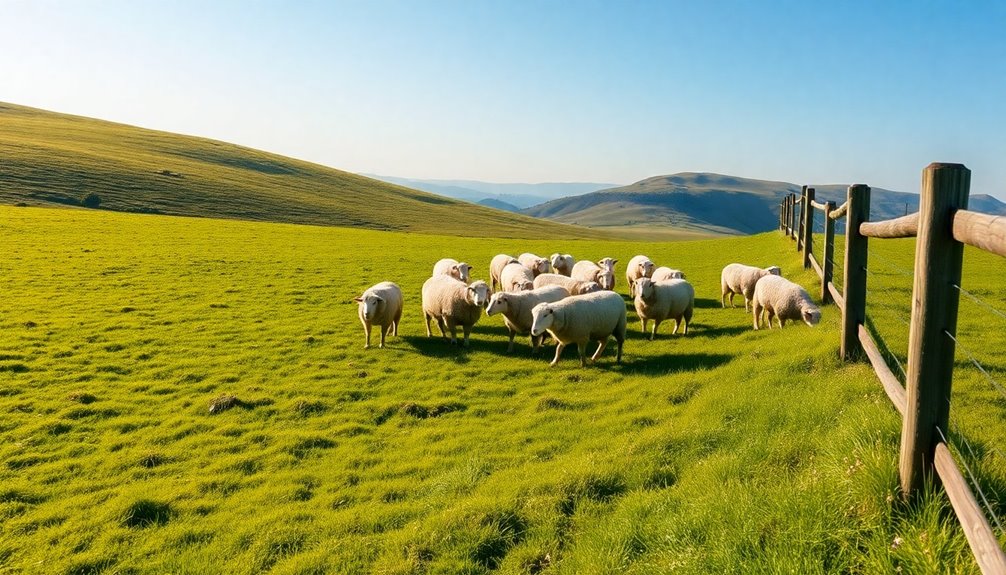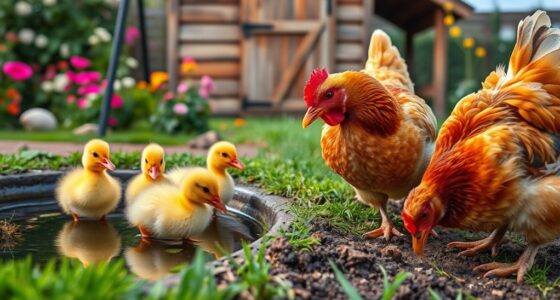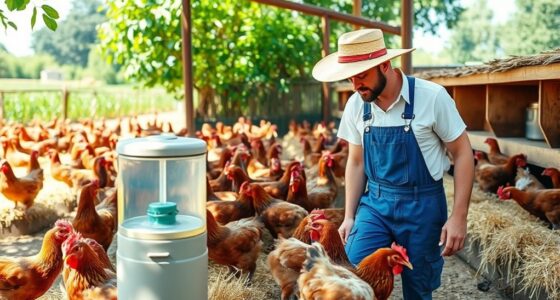To spot heatstroke in rabbits, watch for heavy panting, drooling, rapid breathing, and ears feeling unusually warm. They may become lethargic, unresponsive, or show signs of dehydration like sunken eyes and dry gums. Behavioral changes such as hiding or pacing also indicate distress. If you see these signs, act quickly to cool and hydrate your rabbit. Staying alert helps prevent serious health issues—continue exploring ways to protect your rabbit from heat stress.
Key Takeaways
- Look for heavy panting, drooling, and rapid breathing as early signs of heatstroke.
- Check if the rabbit’s ears feel warm or hot to the touch and the coat appears damp or sweaty.
- Observe behavioral changes like lethargy, hiding, loss of interest in food or water, and disorientation.
- Note physical symptoms such as dry gums, sunken eyes, weakness, or collapse.
- Consider environmental factors like high ambient temperature, poor ventilation, or direct sunlight exposure.
Recognizing the Early Signs of Heatstress

Heatstress can develop quickly in rabbits, so recognizing the early signs before it worsens is vital. You should start by adjusting their diet to include cool, fresh water and easily digestible foods that don’t increase their internal temperature. Limiting exercise is also essential; keep your rabbit in a shaded, cool area and avoid vigorous activity during the hottest parts of the day. Watch for subtle signs like heavy breathing, drooling, or lethargy, which can indicate early distress. Being aware of high ambient temperatures can help you take proactive measures to prevent heatstroke. Additionally, understanding AI safety measures can inform how we implement technology to monitor animal health. Implementing preventive strategies such as cooling mats or fans can further help reduce the risk of heat stress. Using temperature monitoring devices can also alert you to dangerous conditions before symptoms appear. Employing ethical considerations in animal care ensures that interventions are humane and effective. By making these diet adjustments and restricting activity early on, you help prevent the situation from escalating into full-blown heatstroke. Staying vigilant allows you to intervene promptly, ensuring your rabbit’s safety and comfort in hot weather.
Physical Symptoms to Watch For in Affected Rabbits
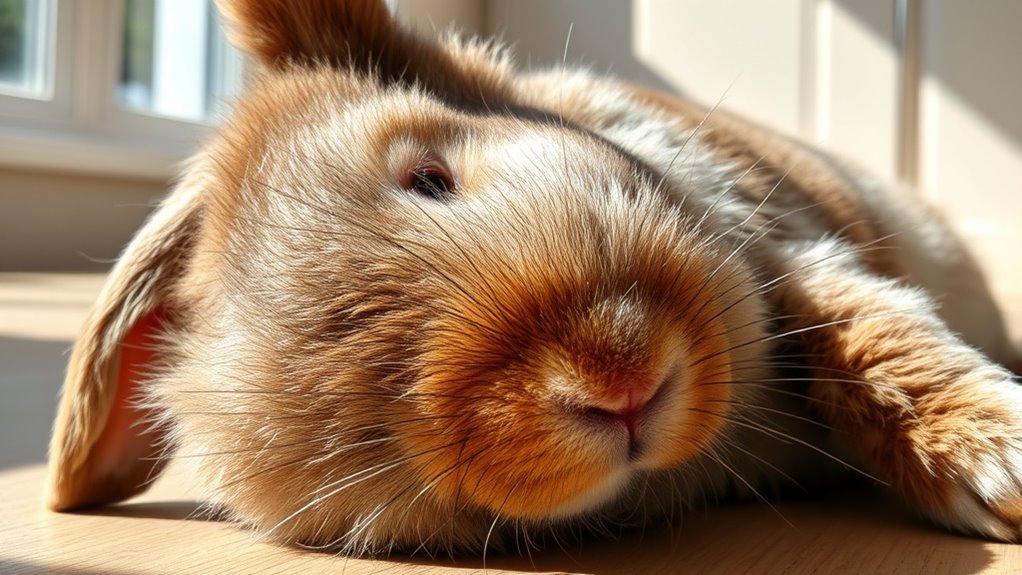
When a rabbit is affected by heatstroke, certain physical symptoms become evident and require immediate attention. You might notice heavy panting, drooling, or rapid breathing, indicating distress. The rabbit’s ears may feel abnormally warm or hot to the touch, and its coat could appear damp or sweaty. You may also see lethargy, weakness, or unresponsiveness. To help, consider dietary adjustments like offering cool, fresh water to encourage hydration. Grooming routines should be modified to keep the fur clean and remove excess sweat or dirt that can trap heat. Be vigilant for signs of dehydration, such as dry gums or sunken eyes. Recognizing these physical symptoms early allows you to act swiftly and prevent the heat from worsening the rabbit’s condition. Monitoring Gold IRA options for future investments can also help safeguard your financial health during stressful times. Additionally, understanding air purifier features can help create a more comfortable environment for your pet during hot weather. Proper ventilation and coastal zone awareness can further minimize the risk of heat-related issues in your rabbit’s living space. Environmental factors like climate control techniques can also greatly assist in preventing heatstroke episodes. Incorporating a HEPA filter in your home air system can reduce airborne pollutants and improve overall air quality for your pet.
Changes in Behavior Indicating Heat-Related Distress
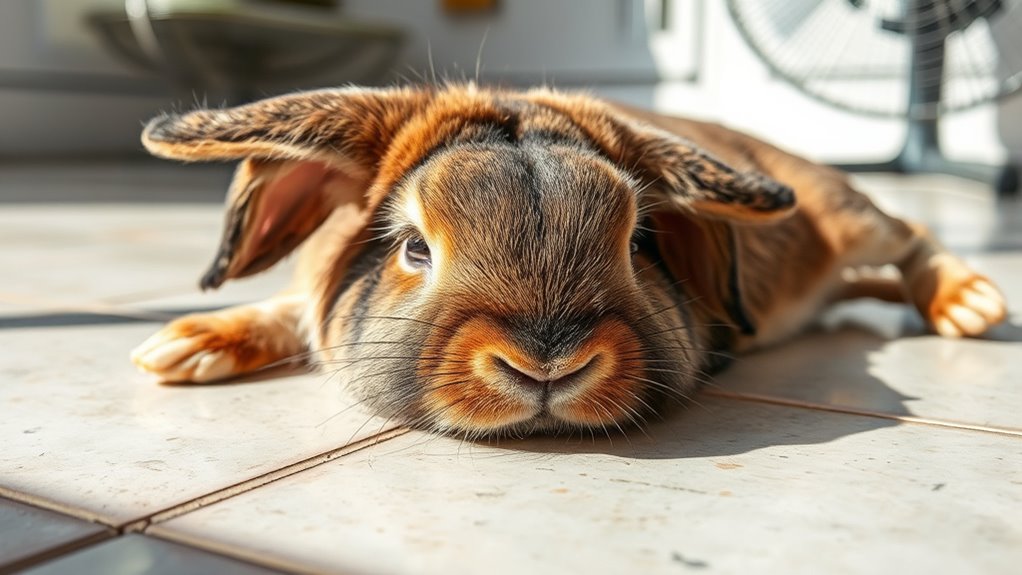
As physical symptoms become more apparent, you may also notice behavioral changes that signal your rabbit is struggling with heat. These behavioral changes often serve as early environmental cues that your rabbit is overheating. You might see your rabbit becoming more lethargic, hiding more than usual, or showing a lack of interest in food and water. Some rabbits may pace or display restless movements, trying to find cooler spots. You could also observe excessive panting or open-mouthed breathing, which aren’t typical behaviors. Be attentive to these signs, as they often indicate your rabbit is experiencing heat-related distress. Recognizing these environmental cues early can help you intervene before the situation worsens. Early detection can make a vital difference in preventing heatstroke. Additionally, understanding vetted care practices can help ensure your rabbit remains safe in hot weather. Maintaining a cool and shaded environment is essential in preventing overheating, especially during peak heat hours. Proper ventilation and access to fresh water are also crucial components of heat safety for rabbits. Incorporating behavioral cues into your daily checks can further improve your ability to respond promptly.
How to Differentiate Heatstroke From Other Illnesses

Distinguishing heatstroke from other illnesses in rabbits can be challenging because many symptoms overlap. For example, lethargy and loss of appetite are common in both heatstroke and gastrointestinal issues. To tell them apart, observe your rabbit’s environment and recent activities. Heatstroke often occurs during hot weather or after exposure to high temperatures, especially if grooming practices have been neglected, leading to poor grooming and heat retention. A rabbit with heatstroke may show rapid breathing, excessive drooling, and a flushed face. In contrast, other illnesses may present with different signs, such as diarrhea or abnormal stool. Monitoring your rabbit’s diet helps too—sudden changes may indicate a different problem. Always consider environmental factors and grooming habits when differentiating heatstroke from other health issues. Additionally, awareness of digital literacy programs can support caregivers in recognizing early warning signs through reliable information sources. Recognizing the importance of proper grooming practices can also prevent heat retention and reduce the risk of heatstroke. Maintaining a healthy living environment with appropriate temperature control is crucial for preventing heat-related health issues. Understanding symptom recognition can further improve early intervention and care.
Immediate Actions to Take When You Suspect Heatstroke
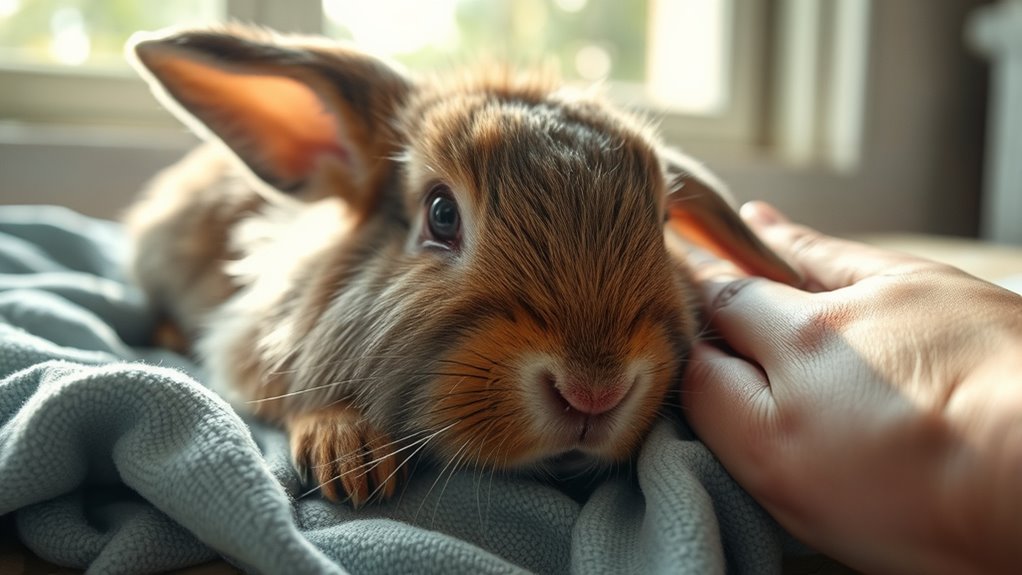
If you suspect your rabbit is experiencing heatstroke, acting quickly can save its life. First, move your rabbit to a shaded, cool area to provide immediate sun protection. Use a damp cloth or cool, wet towels on its ears, belly, and paws to help lower its body temperature. Avoid cold water or ice packs, which can cause shock. Implement hydration strategies by offering fresh, cool water, encouraging your rabbit to drink. If your rabbit shows signs of distress, such as labored breathing or lethargy, seek veterinary care immediately. Keep monitoring its temperature if possible, but do not delay professional help. Quick, decisive action targeting sun protection and hydration can drastically improve your rabbit’s chances of recovery. Recognizing vetted small wood stoves and other heating options can help prevent heat-related issues when outdoor temperatures fluctuate. Additionally, understanding mindfulness techniques, such as deep breathing or visualization, can help pet owners stay calm and focused during emergency situations. Being aware of industry transformations like AI automation can also inform better preparedness strategies to handle unexpected health crises in pets. Being knowledgeable about preventive measures can help you avoid heatstroke altogether by managing your rabbit’s environment effectively.
Preventive Measures to Keep Your Rabbit Cool
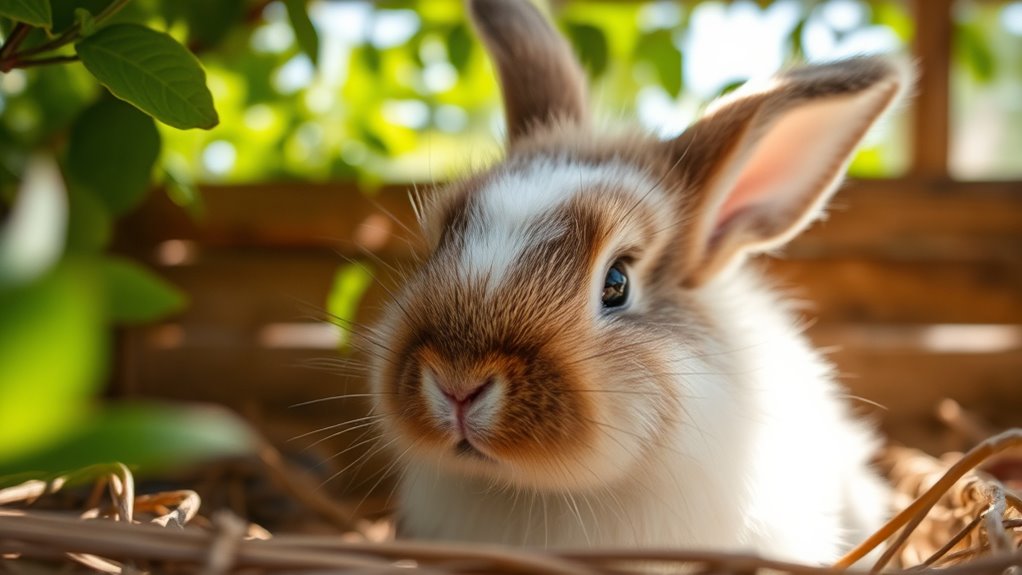
To keep your rabbit cool, make sure they have plenty of shade and good ventilation in their enclosure. You should also provide fresh, cool water throughout the day to prevent dehydration. These simple steps can considerably reduce the risk of heatstroke during hot weather.
Provide Shade and Ventilation
Providing shade and ensuring proper ventilation are essential steps to keep your rabbit cool and prevent heatstroke. A shaded enclosure shields your rabbit from direct sunlight, reducing the risk of overheating. When setting up the enclosure, consider using natural shade like trees or a shade cloth that allows airflow. Ventilation tips include positioning the enclosure in a breezy spot and adding mesh sides to promote air circulation. Good airflow helps dissipate heat and humidity, making your rabbit more comfortable. Avoid placing the cage in stagnant, stuffy areas. By combining a shaded enclosure with proper ventilation, you create a cooler environment that minimizes heat stress. Regularly check that the shade remains effective and that air moves freely to keep your rabbit healthy during hot days.
Offer Fresh, Cool Water
Offering your rabbit fresh, cool water is one of the most effective ways to prevent heatstroke. Proper hydration techniques help keep your rabbit’s body temperature down and prevent dehydration. To enhance this, consider environmental modifications like placing multiple water sources around their enclosure or using ceramic bowls that stay cooler longer. Regularly changing the water ensures it remains fresh and inviting. You can also add ice cubes to boost cooling effects during hot days. Make sure water is easily accessible, especially during peak heat hours. Hydration and environmental adjustments work together to keep your rabbit comfortable and safe. Remember, a well-hydrated rabbit is less likely to suffer from heat-related illnesses. Keep water fresh, cool, and plentiful to support your rabbit’s health.
Long-Term Care and Monitoring After a Heat-Related Episode
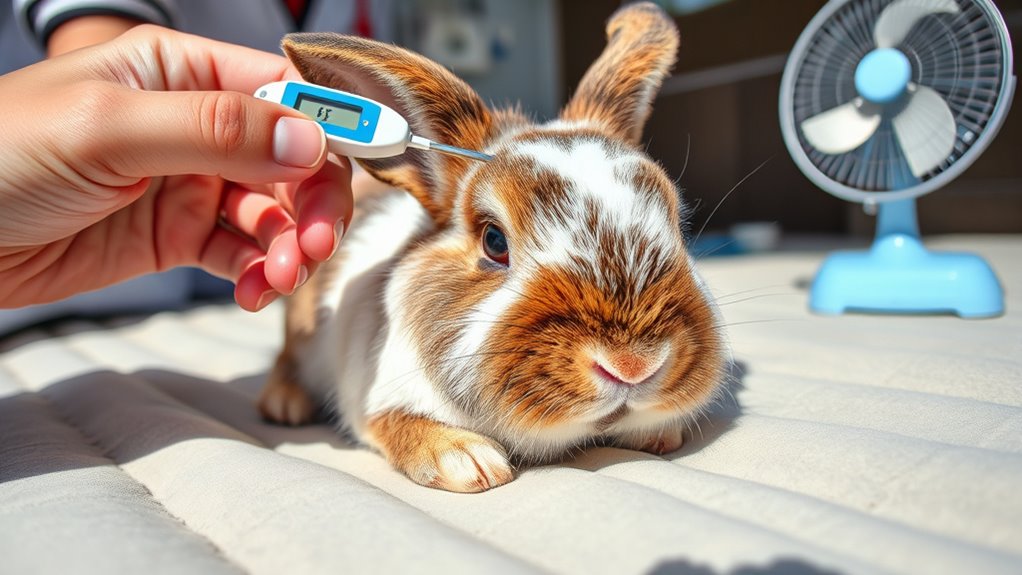
After a heat-related episode, ongoing care and vigilant monitoring are essential to guarantee your rabbit’s full recovery and prevent future incidents. Long-term monitoring involves regularly checking your rabbit’s behavior, appetite, and hydration levels to catch any signs of lingering discomfort or heat sensitivity. Make environmental adjustments by providing shaded, cool, and well-ventilated spaces, and avoid exposing your rabbit to high temperatures. Keep the enclosure in a cool area, use fans or air conditioning if necessary, and ensure fresh water is always available. Observe your rabbit for any changes in activity or breathing that could indicate ongoing stress. Consistent monitoring helps you respond quickly and adapt care as needed, supporting a safe, healthy recovery.
Frequently Asked Questions
Can Heatstroke Occur in Rabbits During Winter?
Heatstroke typically occurs in hot weather, but rabbits can also experience cold stress during winter chills if they’re exposed to drafts or kept in unheated, cold environments. While unlikely, it’s possible for rabbits to suffer from heat-related issues if they’re in a warm, poorly ventilated space despite the cold outside. Always guarantee your rabbit stays comfortable, protected from extreme temperatures, whether it’s summer or winter.
Are Certain Rabbit Breeds More Prone to Heatstroke?
Certain rabbit breeds are more prone to heatstroke due to breed susceptibility and coat density. Breeds with dense coats, like Angoras or Rex, trap heat more easily, increasing their risk. You should be especially cautious with these breeds during hot weather, providing plenty of shade, ventilation, and fresh water. Recognizing breed susceptibility helps you prevent heatstroke by adjusting care to your rabbit’s specific needs.
How Does Humidity Affect Heatstroke Risk in Rabbits?
Humidity levels act like a thick blanket, trapping heat and making it harder for your rabbit to cool down. High humidity causes heat retention, increasing the risk of heatstroke. When the air is moist, rabbits struggle to evaporate moisture from their fur, much like sweating in humans. Keep an eye on humidity levels, especially during hot days, to help your bunny stay cool and safe.
Can Diet Influence a Rabbit’s Susceptibility to Heat Stress?
You might wonder if diet impacts a rabbit’s susceptibility to heat stress. Nutrition influence plays a key role; a well-balanced diet with plenty of fresh hay, vegetables, and water helps maintain hydration and healthy body temperature. Avoid high-fat or sugary treats, which can increase internal heat. Proper diet supports your rabbit’s ability to regulate temperature, reducing heat stress risks during hot weather.
What Are Long-Term Health Effects After a Heatstroke Episode?
Like a storm that leaves a lasting scar, heatstroke can cause serious long-term health effects in rabbits. You might notice chronic organ damage or ongoing neurological issues, which can impact their quality of life. It’s essential to monitor your bunny closely after an episode, providing proper care and regular vet check-ups. Acting swiftly can help minimize lasting damage, ensuring your rabbit’s health and happiness for years to come.
Conclusion
By staying vigilant and acting swiftly, you become the shield guarding your rabbit against the scorching sun. Recognize the warning signs early, like a lighthouse guiding ships safely to shore. With attentive care and preventive measures, you can keep your furry friend cool and comfortable, turning hot days into a breeze rather than a storm. Remember, your watchful eye is the key to ensuring your rabbit’s health and happiness in the heat.

